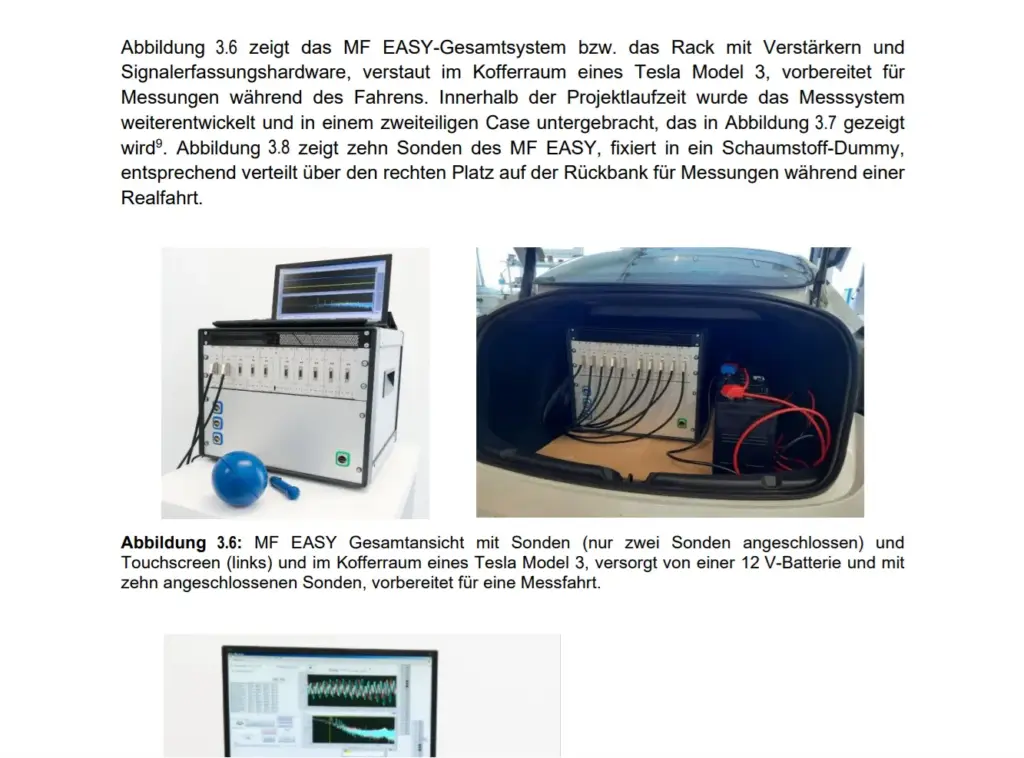Spotlight on BfS 2025 Study: A Focus on Absolute Levels

The 2025 study by the German Federal Office for Radiation Protection (BfS) carried out a systematic series of measurements and simulations to assess magnetic field exposure in thirteen vehicles: eleven electric (EV) and two plug-in hybrids (PHEV).
The findings showed that even under low-demand conditions like steady or “gentle” driving, peak magnetic fields exceeded 100 µT (1000 mG). Under more dynamic driving (such as rapid acceleration or braking), field levels rose significantly, with the highest recorded peak reaching 900 µT (9000 mG). During cruising at constant speeds, the exposure ranged between 2 and 10.5 µT (20 to 105 mG).
After applying mathematical exposure models, the study found that these cars complied with the acute exposure limits of the ICNIRP 2010 guidelines. However, they did not meet the older ICNIRP 1998 acute thresholds. The study did not attempt to assess long-term (chronic) exposure effects, yet the consistently elevated values recorded far surpass the thresholds advised under the precautionary principle for prolonged exposure.

A Closer Look at Magnetic Field Levels in Electric and Hybrid Cars
The 2025 study by the German Federal Office for Radiation Protection (BfS) is among the most detailed analyses ever done on magnetic field exposure inside electric and plug-in hybrid vehicles. Researchers collected more than 975,000 data points under carefully controlled conditions. Tests were run on chassis dynamometers, private tracks, and regular roads (each meant to reflect real-world use), from steady cruising to intense acceleration and braking. This wide range of setups allowed the study to map how magnetic fields behave under different loads and speeds.
To put the numbers into perspective: magnetic field levels are measured in microtesla (µT) or milligauss (mG), with 1 µT equal to 10 mG. When cars were driven at a steady speed, the magnetic fields inside ranged from 2 to 10.5 µT (or 20 to 105 mG). While these may seem moderate, they are already far above precautionary levels set for long-term exposure in some European countries, where recommended limits for chronic exposure are as low as 0.4µT( 4mG).
The Function of Transient Peaks
A primary observation from the BfS 2025 study was the sharp rise in magnetic field levels during quick changes in vehicle motion, particularly when speeding up or braking suddenly. In these brief moments, magnetic fields shot up past 90 µT (9000 mG). These spikes were measured mostly near the floor, around the driver’s and passengers’ legs. The study linked them to sudden currents running through the vehicle’s electric motor and other electronic parts.
These short bursts are overlooked by the current measurements standards. For example, the IEC 62764-1:2022 standard, often used to measure magnetic fields in cars, doesn’t ask for data on events shorter than 200 milliseconds. The BfS report points out that this is a major gap. These brief surges caused the highest exposures in the study and might be important when thinking about how magnetic fields affect human health.
ICNIRP Standards: Acute vs. Chronic Exposure Limits
The BfS study compared measured magnetic fields in vehicles to two reference standards published by the International Commission on Non-Ionizing Radiation Protection (ICNIRP): one from 1998 and one from 2010. The older 1998 version sets lower thresholds for short-term (acute) exposure, especially for peak magnetic field values.
The results show that when applying computational models (which estimate electric fields inside the body), all tested vehicles stayed within the 2010 ICNIRP limits for acute exposure. However, direct measurements of magnetic field strength (without modeling) revealed that several vehicles exceeded the stricter 1998 limits. This was mainly seen during operating modes that require high electric power, such as hard braking with energy recovery or rapid acceleration.
Notably, the study did not assess long-term (chronic) exposure. But when comparing the measured levels to precautionary thresholds used in public health studies, concerns arise. In particular, magnetic fields often went significantly above the 0.4µT( 4mG) level that multiple epidemiological studies have linked to a higher risk of childhood leukemia (source: WHO Environmental Health Criteria 238).
Not Only from the Drive System
Although electric motors and high-voltage cables are often seen as the main sources of magnetic fields in electric vehicles, the BfS study reveals that other parts of the car also play a major part. Systems such as seat heaters, dashboard electronics, and media units were shown to create noticeable magnetic fields inside the cabin. In some cases, these secondary sources produced exposure index levels similar to those from the main drive components.
Measurements taken when the vehicle was not moving (only accessories turned on) still showed local magnetic field levels above 100 µT (1000 mG). This shows that magnetic exposure is not limited to driving alone. It can also occur during times when the car is standing still, like when it’s warming up or the electronics are running while parked.
Public vs. Private Transport: A Closer Look at Exposure Patterns
To give a broader perspective, the study included measurements taken on public transport systems such as trams, subways, and regional trains. Some of these vehicles, especially those operating on 800 V DC or 15 kV/16.7 Hz AC power systems, showed magnetic field levels at certain seats that met or exceeded ICNIRP reference values.
Still, although public transport can show high levels, private electric and plug-in hybrid vehicles (particularly during rapid acceleration or braking) produced sharper and more frequent field spikes. These peaks were concentrated in specific parts of the body, like the lower legs. The study noted that such local hotspots are often overlooked in standard measurement methods and existing exposure guidelines.
Limitations in Chronic Exposure Assessment
The study confirmed that, after using mathematical models, all the vehicles tested stayed within the short-term exposure limits set by ICNIRP 2010. However, several of them went over the older limits from ICNIRP 1998. The study didn’t look at long-term or repeated exposure. Still, when you look at the magnetic field levels measured (especially during things like acceleration or braking), it’s clear that well-known precautionary limits for chronic exposure were passed by a wide margin.
The BfS team does not offer a direct conclusion regarding health outcomes from long-term exposure. However, they point to a clear mismatch between the nature of typical exposure in vehicles and the scenarios addressed by existing safety limits. As people spend more time in electric and hybrid vehicles year after year, accumulated exposure becomes increasingly relevant and cannot be ignored in future health assessments.
Bridging the Gap Between Standards and Reality
The BfS 2025 study presents a clear technical observation: magnetic field levels inside today’s electric and hybrid vehicles can, in many cases, exceed levels considered safe under precautionary health-based guidelines (e.g., “ICNIRP 1998 acute reference levels or precautionary chronic exposure thresholds”), particularly during:
- Acceleration
- Braking
- Other high-load events
Although the vehicles studied meet the requirements for acute exposure under one of the standardized test conditions (ICNIRP 2010), these tests do not fully capture the real-world occurrence of short bursts or repeated exposure. For example, current standards do not account for magnetic field spikes lasting under 200 milliseconds, and more importantly, nor do they consider long-term daily use patterns.
As the use of electric vehicles continues to rise, further scrutiny of both absolute field levels and chronic exposure scenarios will likely be needed. The BfS report provides a thorough baseline, both for continued measurement and for the development of more detailed safety criteria in the context of long-term exposure.
References
- Federal Office for Radiation Protection (BfS) (2025). Determination of exposure to electromagnetic fields from electromobility (Project 3620S82473)
- International Commission on Non-Ionizing Radiation Protection (ICNIRP) (2010). Guidelines for limiting exposure to time-varying electric and magnetic fields (1 Hz to 100 kHz)
- International Commission on Non-Ionizing Radiation Protection (ICNIRP) (1998). Guidelines for limiting exposure to time-varying magnetic fields (up to 100 kHz)
- International Electrotechnical Commission (IEC) (2022). Measurement procedures of magnetic field levels generated by electronic and electrical equipment in the automotive environment with respect to human exposure – Part 1: Low frequency magnetic fields.
- World Health Organization. (2007). Environmental Health Criteria 238: Extremely Low Frequency Fields

